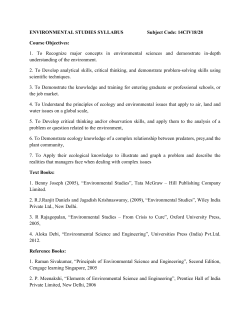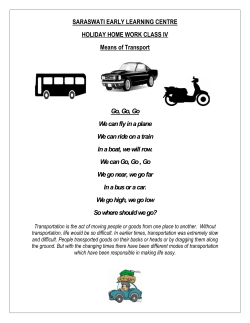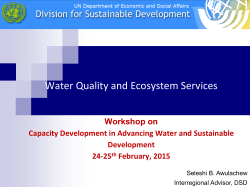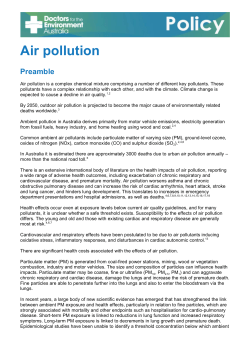
APES – UNIT 5 STUDY GUIDE
APES – UNIT 5 STUDY GUIDE Chapter 15 1. According to your textbook, what is the “gray zone” of suboptimal health? 2. How are pollutants categorized? Give 3 specific examples of each type of pollutant. 3. Why is there controversy and concern about synthetic organic compounds such as dioxin? 4. Describe the process of biomagnifications and why it is important in toxicology. 5. What are the five main effects of pollutants on wildlife and/or humans? Give 3 examples of pollutants in each category. 6. What did the physician and alchemist Paracelsus mean by “everything is poisonous, yet nothing is poisonous.”? 7. What is the dose-response concept and how does it relate to LD-50, TD50, ED-50, ecological gradients and tolerance? 8. List and describe the four steps of risk assessment? Why is the process of risk assessment often difficult and controversial? 9. What are the seven deadliest infectious diseases in order of the number of deaths they cause each year? 10. Describe two ways that infectious bacteria become resistant to antibiotics. List four facts that promote such bacterial resistance. 11. In terms of deaths, what are the three most serious viral diseases? 12. Distinguish between HIV and AIDS. About how many people in the world (a) are infected with HIV, (b) have died of AIDS, and (c) are expected to die of AIDS between 2010 and 2020? 13. What causes malaria? About how many people die from malaria each year? List four ways to help prevent this disease. Chapter 21 1. 2. 3. 4. 5. 6. 7. 8. 9. List eight unique properties of water and explain the importance of each property. What percentage of the earth’s total volume of water is easily available for use by people? Since 1975, how much has the total use and per capita use of water by humans increased? Describe the interactions between surface water and groundwater. How can these interactions result in pollution of groundwater? Approximately how many people in the US use groundwater as a primary source for drinking water? What are the problems associated with groundwater use? What is desalination? What are the pros and cons of using this as a water source? Distinguish between off-stream and in-stream water use. Give at least 5 examples of each. Approximately what percentage of water we withdraw each year is used for (a) irrigation, (b) industry, and (c) residences and cities? What is water conservation? Describe what and how each of the following uses could benefit from conservation efforts: a. Agricultural use b. Domestic use c. Industry and Manufacturing use 10. Why is the perception of water use an important tool in conservation efforts? 11. Describe six general criteria for water use sustainability. 12. How does the city of Santa Barbara use the variable-water-source approach? 13. Describe eight natural service functions of wetlands. What percentage of freshwater wetlands have disappeared? How have wetlands began to be restored? 14. Describe four environmental effects of dams. 15. What is channelization? Describe five environmental effects of channelization. 16. Describe the major advantages and disadvantages of (a) building numerous dams along the Colorado River basin and (b) China’s Three Gorges dam. 17. Describe how our growing water shortage is linked to potential food supply issues. Chapter 22 1. What is the definition of water pollution? What is the primary water pollution problem in the world today? 2. What are the major sources and processes of surface water pollution? Groundwater pollution? 3. What are the nine categories of water pollution? Give two examples of each. 4. How is biochemical oxygen demand (BOD) used in water quality management? How does BOD get introduced into streams and rivers? 5. What are some common waterborne diseases? 6. What two important nutrients cause water pollution problems? How are they released/introduced into the environment and waterways? 7. Describe the example of Medical Lake. 8. Distinguish between eutrophication and cultural eutrophication. What are the major causes of cultural eutrophication? What is the solution to cultural eutrophication? 9. What is the so-called dead zone in the Gulf of Mexico? How can it be reduced? 10. How is oil commonly released into surface water? 11. Describe the example of the Exxon Valdez in Prince William Sound, Alaska. 12. How does sediment affect water quality? How can it be reduced? 13. Where is acid mine drainage a significant water pollution problem? 14. Give four examples of point source water pollutants and nonpoint source water pollutants. What are the two approaches to dealing with surface water pollution? 15. What percentage of known waste disposal sites in the US may be contaminating our groundwater resources? 16. How does groundwater pollution differ from surface water pollution? 17. Describe the process of wastewater treatment. Distinguish between primary treatment, secondary treatment, and advanced wastewater treatment. 18. What are some problems associated with chlorine treatment of wastewater? 19. What are the major steps of the wastewater renovation and conservation cycle? 20. How can wetlands (natural and constructed) be used to treat water quality problems? 21. Distinguish between inadvertent, indirect and direct water reuse. What are the risks associated with inadvertent reuse? 22. What are the major environmental laws dealing with water pollution?
© Copyright 2025





















